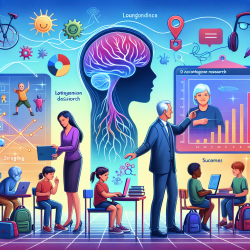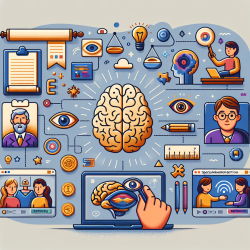In the ever-evolving field of speech-language pathology, the ability to make data-driven decisions is paramount. The recent publication, "A longitudinal resource for population neuroscience of school-age children and adolescents in China," offers invaluable insights that can significantly enhance therapeutic outcomes for children. This blog aims to distill the key findings from this research and provide actionable strategies for practitioners.
Understanding the Research
The study by Fan et al. (2023) provides a comprehensive longitudinal dataset focusing on the brain-mind development of school-age children and adolescents in China. The dataset includes phenotypic and neuroimaging data collected over multiple years, offering a robust resource for understanding normative brain growth and its variations.
Key Findings
The research highlights several critical findings:
- Normative Brain Growth Curves: The study presents normative growth curves for various brain structures, including total cortical grey matter volume (GMV), white matter volume (WMV), and cortical thickness (CT).
- Regional Differences: The study identifies regional differences in brain development between Chinese and American children, emphasizing the importance of considering cultural and geographical contexts in therapeutic approaches.
- Developmental Milestones: The research outlines key developmental milestones and their association with cognitive and behavioral functions, providing a timeline for expected developmental changes.
Implementing Research Outcomes in Practice
Practitioners can leverage these findings to improve therapeutic interventions for children. Here are some strategies:
1. Personalized Therapy Plans
Use the normative brain growth curves to tailor therapy plans according to the individual developmental trajectories of children. Understanding where a child stands relative to these curves can help in setting realistic goals and expectations.
2. Early Identification and Intervention
The study's detailed milestones can aid in the early identification of developmental delays or abnormalities. Early intervention can be crucial in mitigating long-term impacts, and this research provides a benchmark for identifying children who may need additional support.
3. Culturally Responsive Therapy
Given the regional differences highlighted in the study, it's essential to incorporate culturally responsive practices in therapy. This might involve adapting communication styles, therapy materials, and engagement strategies to align with the child's cultural background.
4. Collaborative Research
Encourage collaborative research efforts to expand the dataset and validate findings across different populations. This can help in refining the normative curves and enhancing the generalizability of the research outcomes.
Encouraging Further Research
While the current dataset is a significant step forward, there is always room for further research. Practitioners are encouraged to:
- Participate in Longitudinal Studies: Contribute to ongoing longitudinal studies to help build more comprehensive datasets.
- Conduct Cross-Cultural Comparisons: Initiate studies that compare brain development across different cultural contexts to further understand regional variations.
- Explore New Therapeutic Approaches: Use the dataset to test and validate new therapeutic interventions aimed at improving cognitive and behavioral outcomes in children.
Conclusion
The research by Fan et al. (2023) offers a treasure trove of data that can significantly enhance therapeutic outcomes for children. By implementing the research findings and encouraging further studies, practitioners can contribute to a more nuanced understanding of child development and deliver more effective, personalized therapy.To read the original research paper, please follow this link:
A longitudinal resource for population neuroscience of school-age children and adolescents in China.










